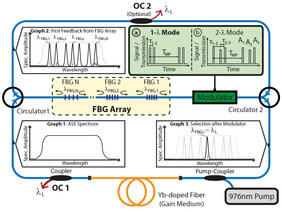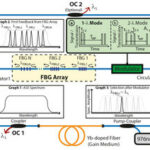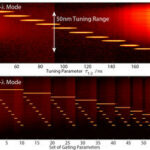- Home
- Research
- Fiber Research and Technology
- Research results
- Tunable All-Fiber Lasers with Single and Dual-Wavelength Emission
Tunable All-Fiber Lasers with Single and Dual-Wavelength Emission

12.04.2018
Tunable fiber lasers feature a variable emission wavelength for spectrally sensitive applications. We will be introducing a tuning concept that is based on fiber Bragg grating arrays and employs an electrical control signal to switch between a single-wavelength and an independently-tunable dual-wavelength emission. It comprises unique features providing many prospects to target increased challenges in spectroscopy and life sciences.
By: Tobias Tiess // Martin Becker // Manfred Rothhardt // Hartmut Bartelt // Matthias Jäger
Tunable lasers are characterized by an adjustable emission wavelength λL, which can be adapted to the needs of different applications within the gain region of the laser-active medium. This is of crucial importance for spectrally demanding applications such as telecommunications, material processing, and especially biophotonics. Fiber lasers not only excel in these fields of application with their very high efficiency and excellent beam quality but are also characterized by a very robust, compact, and low-maintenance design, especially in the fiber-integrated layout. In addition, active laser fibers typically possess very wide gain regions, which allow a large working window for λL. With their cost-efficient layout, fiber lasers show great potential to replace expensive key technologies based on free-space coupled solid-state lasers in the fast-growing fields of biophotonics and medical technology.
In recent years, a new tuning concept for fiber lasers has been developed at IPHT, which uses fiber Bragg gratings (FBGs) as narrow-band mirrors inscribed in the fiber core for flexible spectral filtering. By combining many of these gratings into an FBG array, the filter not only offers unique spectral freedom for customized tuning ranges and large bandwidths but also the advantages of fiber-integrated assemblies due to its monolithic structure. The manufacture of these diverse filter structures is based on the broad technological foundation of IPHT, which includes, among other things, direct fabrication during fiber drawing and inscription of the gratings with an ultrafast pulsed laser.
To enable the broadband filter to be used for active control of the emission wavelength λL of fiber lasers, the distribution of the gratings along the fiber axis of the FBG array is used (see Fig. 1). Due to the different propagation lengths, each wavelength of the discrete filter has a different response time. Integrated in a theta-ring resonator, λL can be controlled by an electrical control signal with two short transmission windows on an optical modulator (left part of the green box in Fig. 1). The time interval between the two transmission windows specifies a response time of the FBG array with respect to the modulator, which is uniquely linked to a grating position and thus to a response wavelength of the spectral filter. Accordingly, this wavelength specifies the spectral emission characteristics of the laser by minimizing round trip losses in the resonator. Via parameter τ1-2 of the periodic modulation signal, the laser emission is coupled to a selected response grating and thus λL (1-λ mode) is discretely tuned.
The concept in Fig. 1 was investigated based on an ytterbium-doped laser system. Fig. 2a) shows the tuning spectrogram of the laser. By measuring the spectrum as a function of the tuning parameter τ1-2, the graph shows the spectral emission behavior over the tuning range. A discrete tuning range of up to 50 nm around 1.06 µm was able to be implemented, which is currently only limited by the bandwidth of the FBG array. Over the entire tuning range, the system is characterized by excellent emission properties such as a narrow line width of <200 pm and a high signal contrast of commonly >40 dB.
As a unique feature of the tuning concept, the theta ring resonator – in combination with the electrical control signal – allows an additional operating mode with several tunable wavelengths being emitted by the laser. This was carried out experimentally with a synchronous dual-wavelength operation (2-λ mode). As shown in Fig. 1 (green box, right side), a third transmission window is attached to the timing control signal. This favors two response times of the FBG array and thus selects two emission wavelengths λL1 and λL2. These can be tuned spectrally independently of each other via the time intervals τ1-3 and τ2-3 and thus offer unprecedented freedom for the spectral emission properties of the system. The spectral amplitudes can be easily compensated by the electronic amplitude parameters A1, A2, and A3. Due to the unique flexibility of the laser design, an adapted electrical control signal enables both tunable single-wavelength operation (1-λ mode) and independently tunable dual-wavelength operation (2-λ mode) or multi-wavelength operation.
The experimental demonstration of dual-wavelength operation is based on the ytterbium-doped fiber laser from Fig. 1. Based on an FBG array with eleven different gratings, various combinations of control parameters were set for the proof-of-principle, and the associated dual-wavelength spectrum was recorded. This results in a total of fifty-five different wavelength pairs in the emission spectrum. In the tuning spectrogram in Fig. 2b, the associated emission spectra (in columns) are shown in 2-λ mode. The detection of fifty-five wavelength pairs demonstrates the unique independent tunability of both wavelengths λL1 and λL2, maintaining the excellent spectral characteristics of single-wavelength operation with a narrow line width and excellent signal contrast even in multi-wavelength mode.
The new tuning concept offers great potential for opening up new areas of application with fiber lasers. In addition to the many advantages of a fiber-integrated laser, the flexibility of FBG arrays and the new tuning concept enable tailored spectral emission properties. Especially the independently tunable dual-wavelength mode offers great potential for spectroscopic applications.
Funded by: BMBF


